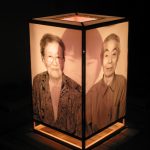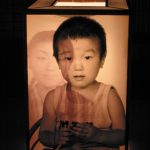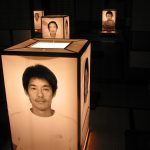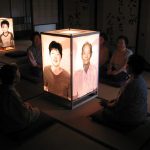- Installation view
- Installation view
- Installation view
- Installation view
2 N D E C H I G O – T S U M A R I T R I E N N I A L, Minami Abuzaka, Niigata, 2003
Director: Fram Kitagawa
wood, photographs, light
Ten large lanterns occupy an uninhabited house one or two per room. Sitting in front of the lanterns, viewers face vivid, lifelike photo-portraits representing multiple generations of a single family. The viewer’s eyes momentarily align with superimposing eyes of both the unmoving exterior portrait and the rotating interior portrait. In this single moment, past, present and future “see through eyes.” Viewer becomes a meeting point for the palpable force of family ties—land and people as ancient, yet present. The intent of this austere viewing is to invite sudden meeting with a radical presence, the “tamashi” or human spirit, the very ancestors, who still somehow inhabit family lineage. Nagasawa lived in the house while collecting neighbors’ memories in recorded stories, played back as emanations from the attic.
At Nagasawa’s request, an old calligrapher inscribed a text in Japanese on the fusuma (sliding door) in the main gathering room. This inscription adapts a famous phrase by the medieval Christian mystic Meister Eckhart, substituting the word “tamashi” for God by writing, “The eye with which I see tamashi is the eye with which tamashi sees me.” As people gathered by the lanterns, they brought new vitality to the house and this village where depopulation was painfully in evidence.







